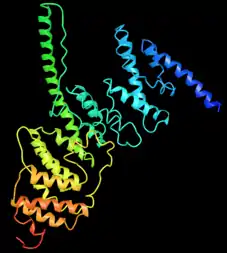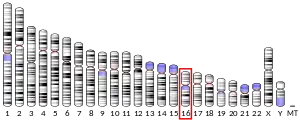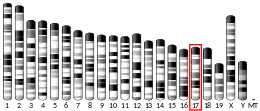| TEDC2 | |||||||||||||||||||||||||||||||||||||||||||||||||||
|---|---|---|---|---|---|---|---|---|---|---|---|---|---|---|---|---|---|---|---|---|---|---|---|---|---|---|---|---|---|---|---|---|---|---|---|---|---|---|---|---|---|---|---|---|---|---|---|---|---|---|---|
| Identifiers | |||||||||||||||||||||||||||||||||||||||||||||||||||
| Aliases | TEDC2, C16orf59, chromosome 16 open reading frame 59, tubulin epsilon and delta complex 2 | ||||||||||||||||||||||||||||||||||||||||||||||||||
| External IDs | MGI: 1919266 HomoloGene: 45943 GeneCards: TEDC2 | ||||||||||||||||||||||||||||||||||||||||||||||||||
| |||||||||||||||||||||||||||||||||||||||||||||||||||
| |||||||||||||||||||||||||||||||||||||||||||||||||||
| |||||||||||||||||||||||||||||||||||||||||||||||||||
| |||||||||||||||||||||||||||||||||||||||||||||||||||
| Wikidata | |||||||||||||||||||||||||||||||||||||||||||||||||||
| |||||||||||||||||||||||||||||||||||||||||||||||||||
Tubulin epsilon and delta complex 2 (TEDC2), also known as Chromosome 16 open reading frame 59 (C16orf59), is a protein that in humans is encoded by the TEDC2 gene. Its NCBI accession number is NP_079384.2.[5]
Gene

Locus
TEDC2 is found on chromosome 16 at location 16p13.3, or chr16:2,460,080-2,464,963 (spanning 4883 bp) on the plus strand.[6]
Homology and Evolution
Orthologs
TEDC2 appeared between 684-797 million years ago. Its most distant ortholog is found in Branchiostoma floridae, the Florida lancelet,[7] which diverged from other chordates around 684 million years ago.[8] However, the gene arose more recently than 797 million years ago, when protostomes and deuterostomes diverged,[8] as it is not found in any invertebrates. A table showing 20 selected orthologs is below, found with NCBI BLAST.[5]
| Genus and species | Common name | Clade | Date of divergence (estimated)[8] | Accession number | Length | Identity | Similarity |
| Homo sapiens | Human | Mammalia | 0 MYA | NP_079384.2 | 433 aa | 100% | 100% |
| Pan troglodytes | Chimpanzee | Mammalia | 6.65 MYA | XP_001163226.2 | 433 aa | 98% | 98% |
| Mus musculus | House mouse | Mammalia | 90 MYA | NP_082332.1 | 436 aa | 62% | 72% |
| Orcinus orca | Orca | Mammalia | 96 MYA | XP_012388677.1 | 445 aa | 71% | 78% |
| Vulpes vulpes | Red fox | Mammalia | 96 MYA | XP_025840713.1 | 432 aa | 68% | 74% |
| Dasypus novemcinctus | Nine-banded armadillo | Mammalia | 105 MYA | XP_012385078.1 | 469 aa | 69% | 77% |
| Cyanistes caeruleus | Eurasian blue tit | Aves | 312 MYA | XP_023792200.1 | 366 aa | 44% | 59% |
| Pygoscelis adeliae | Adélie penguin | Aves | 312 MYA | XP_009325519.1 | 490 aa | 43% | 58% |
| Columba livia | Rock dove | Aves | 312 MYA | XP_021147488.1 | 511 aa | 43% | 56% |
| Numida meleagris | Helmeted guineafowl | Aves | 312 MYA | XP_021267460.1 | 574 aa | 40% | 67% |
| Dromaius novaehollandiae | Emu | Aves | 312 MYA | XP_025956253.1 | 547 aa | 40% | 68% |
| Anolis carolinensis | Green anole | Reptilia | 312 MYA | XP_008122311.2 | 473 aa | 32% | 47% |
| Python bivittatus | Burmese python | Reptilia | 312 MYA | XP_007433089.1 | 607 aa | 32% | 50% |
| Pogona vitticeps | Bearded dragon | Reptilia | 312 MYA | XP_020663843.1 | 578 aa | 31% | 45% |
| Xenopus tropicalis | Western clawed frog | Amphibia | 352 MYA | XP_002932464.1 | 452 aa | 30% | 45% |
| Lepisosteus oculatus | Spotted gar | Osteichthyes | 435 MYA | XP_015215377.1 | 193 aa | 37% | 48% |
| Scleropages formosus | Asian arowana | Osteichthyes | 435 MYA | XP_018598511.1 | 186 aa | 29% | 47% |
| Paramormyrops kingsleyae | Elephantfish | Osteichthyes | 435 MYA | XP_023666461.1 | 473 aa | 29% | 46% |
| Callorhinchus milii | Australian ghostshark | Chondrichthyes | 473 MYA | XP_007891790.1 | 540 aa | 32% | 49% |
| Branchiostoma floridae | Florida lancelet | Cephalochordata | 684 MYA | XP_002611730.1 | 602 aa | 23% | 42% |
Paralogs
There are no other members of the TEDC2 gene family, as it has no paralogs in any living organisms.[5]
Expression
Transcription Factors
Conserved predicted transcription factor binding sites found in the 5' region upstream of TEDC2 are WT1, ZKSCAN3 (x2), AREB6, MZF1 (x2), ATF6, ER, and P53.[9] This suggests that these transcription factors in particular, and especially ZKSCAN3 and MZF1 on the basis of multiple conserved binding sites, are crucial in the regulation of TEDC2. ZKSCAN3 is a transcriptional repressor of autophagy,[10] and MZF1 is thought to play a role as a tumor suppressor and regulator of cell proliferation.[11] These conserved MZF1 sites, along with the conserved p53 site, suggest that TEDC2 could play a role in cell proliferation and can therefore impact the genesis and development of cancer.
Localization
TEDC2 is predicted to be localized to the nucleus and may also be present in the cytoplasm, mitochondria, peroxisomes, and extracellular space.[12]
Expression
It is highly expressed in the testis and EBV-transformed lymphocytes.[13] It is also highly expressed in lymph node, fetal liver, early erythroid cell, and B-lymphoblasts.[14] It is also seen at higher levels in both embryonic stem cells and induced pluripotent stem cells than fibroblasts.[14] Finally, relative to other genes, TEDC2 expression significantly decreases in breast cancer cells upon estrogen starvation.[14]
Transcript Variants

The gene has 10 exons.[15] The gene has 13 alternatively spliced transcripts, with 6 coding for a protein, 1 undergoing nonsense-mediated decay, and 6 being retained introns.[16]
Protein
General Features
TEDC2 is encoded by the TEDC2 gene with NCBI accession number NM_025108.3. The protein is 433 amino acids long with a predicted molecular weight of 46.4 kDa.[6] There is an antibody against the protein, but a sample western blot image is not available.[17]
Domains
TEDC2 contains a domain of unknown function, DUF4693, which in humans spans from proteins 148-431, approximately the last two-thirds of the protein.[5]
Secondary Structure
Using online bioinformatics tools, TEDC2 is predicted to have many alpha helices, and it has two well-conserved predicted beta-pleated sheets near the end of the protein.[18][19]
Tertiary Structure

TEDC2 is predicted to form tertiary structure based on its alpha helices. Many of these predicted alpha helices are highly conserved in orthologs, and one example of predicted tertiary structure generated by I-TASSER is shown to the right.[20]
Post-translational Modifications

TEDC2 has a well conserved predicted O-GlcNAc site at S114 in humans.[22] O-GlcNAcylated proteins are found mostly in the nucleus, sometimes also being found in the cytoplasm, and this is a dynamic modification, frequently being removed and reattached.[23]
TEDC2 also has three conserved, predicted C-mannosylation sites.[24] The function of C-mannosylation is still unclear, but it is the attachment of an alpha-mannose to a tryptophan.[25]
TEDC2 also has many possible phosphorylation sites, including seven that are well-conserved.[26] Phosphorylation is an important means of protein regulation, activation, and inactivation, so it is difficult to determine any specific function from the presence of a serine or threonine that could be phosphorylated.[27]
Interactions
Protein-Protein Interactions
KDM1A, a lysine-specific demethylase, was shown to be physically associated with TEDC2.[28][29] TEDC2 also interacts with FEZ1, a fasciculation and elongation protein. FEZ1, or fasciculation and elongation protein 1, is necessary for axon growth but is also thought to be involved in transcriptional control.[30]
There is also experimental evidence for TEDC2 interaction with TUBE1 and C14orf80. TUBE1, or Tubulin epsilon 1, is involved with the centrioles during cell division, and the function of C14orf80 is unknown.[31] TEDC2 is also co-expressed with CDC45, or cell division control protein 45, which is required for initiation of chromosomal DNA replication, as well as co-expression with CDT1, a DNA replication licensing factor required for pre-replication assembly.[32]
Function and Clinical Significance
The function of TEDC2 is not yet known with certainty by the scientific community, but its expression profile, predicted transcription factor binding sites, and other protein-protein interactions enable some predictions. TEDC2 is localized in the nucleus and is often expressed in developing tissues such as stem cells as well as differentiated fetal tissue, so it likely plays a role in DNA replication and/or cell division.[12][14] This also fits with TEDC2's predicted or known protein-protein interactions, as it may interact with proteins involved in cell division (TUBE1, CDC45, CDT1), as well as remain under transcriptional control of tumor suppressors (WT1, MZF1, P53).[9] Additionally, given the presence of an estrogen-response element binding-site, it is possible that TEDC2 plays a role in tumor development when mutated.[9]
References
- 1 2 3 GRCh38: Ensembl release 89: ENSG00000162062 - Ensembl, May 2017
- 1 2 3 GRCm38: Ensembl release 89: ENSMUSG00000024118 - Ensembl, May 2017
- ↑ "Human PubMed Reference:". National Center for Biotechnology Information, U.S. National Library of Medicine.
- ↑ "Mouse PubMed Reference:". National Center for Biotechnology Information, U.S. National Library of Medicine.
- 1 2 3 4 "tubulin epsilon and delta complex protein 2 [Homo sapiens] - Protein - NCBI". www.ncbi.nlm.nih.gov. Retrieved 2019-03-03.
- 1 2 www.genecards.org https://www.genecards.org/cgi-bin/carddisp.pl?gene=TEDC2 . Retrieved 2019-02-08.
- ↑ "hypothetical protein BRAFLDRAFT_128731 [Branchiostoma floridae] - Protein - NCBI". www.ncbi.nlm.nih.gov. Retrieved 2019-02-25.
- 1 2 3 "TimeTree :: The Timescale of Life". www.timetree.org. Retrieved 2019-03-03.
- 1 2 3 "Genomatix: MatInspector Input". www.genomatix.de. Retrieved 2019-05-05.
- ↑ Chauhan S, Goodwin JG, Chauhan S, Manyam G, Wang J, Kamat AM, Boyd DD (April 2013). "ZKSCAN3 is a master transcriptional repressor of autophagy". Molecular Cell. 50 (1): 16–28. doi:10.1016/j.molcel.2013.01.024. PMC 3628091. PMID 23434374.
- ↑ Gaboli M, Kotsi PA, Gurrieri C, Cattoretti G, Ronchetti S, Cordon-Cardo C, Broxmeyer HE, Hromas R, Pandolfi PP (July 2001). "Mzf1 controls cell proliferation and tumorigenesis". Genes & Development. 15 (13): 1625–30. doi:10.1101/gad.902301. PMC 312729. PMID 11445537.
- 1 2 "COMPARTMENTS - C16orf59". compartments.jensenlab.org. Retrieved 2019-02-08.
- ↑ "GTEx Portal - C16orf59". GTEx. Retrieved 2/8/19.
- 1 2 3 4 "Home - GEO - NCBI". www.ncbi.nlm.nih.gov. Retrieved 2019-04-22.
- ↑ "Homo sapiens tubulin epsilon and delta complex 2 (TEDC2), mRNA". 2018-12-29.
{{cite journal}}: Cite journal requires|journal=(help) - ↑ "Gene: TEDC2 (ENSG00000162062) - Summary - Homo sapiens - Ensembl genome browser 95". useast.ensembl.org. Retrieved 2019-02-25.
- ↑ "Anti-C16ORF59 antibody produced in rabbit HPA051394". Sigma-Aldrich. Retrieved 2019-05-05.
- ↑ "CFSSP: Chou & Fasman Secondary Structure Prediction Server". www.biogem.org. Retrieved 2019-04-22.
- ↑ "JPred: A Protein Secondary Structure Prediction Server". www.compbio.dundee.ac.uk. Retrieved 2019-04-22.
- 1 2 "I-TASSER server for protein structure and function prediction". zhanglab.ccmb.med.umich.edu. Retrieved 2019-05-05.
- ↑ "DOG 2.0 - Protein Domain Structure Visualization". dog.biocuckoo.org. Retrieved 2019-05-05.
- ↑ "YinOYang 1.2 Server". www.cbs.dtu.dk. Retrieved 2019-04-22.
- ↑ Varki A, Cummings RD, Esko JD, Stanley P, Hart GW, Aebi M, et al. (2015). "The O-GlcNAc Modification". In Varki A, Cummings RD, Esko JD, Stanley P (eds.). Essentials of Glycobiology (3rd ed.). Cold Spring Harbor Laboratory Press. doi:10.1101/glycobiology.3e.019 (inactive 1 August 2023). PMID 28876858. Retrieved 2019-04-22.
{{cite book}}: CS1 maint: DOI inactive as of August 2023 (link) - ↑ "NetCGlyc 1.0 Server". www.cbs.dtu.dk. Retrieved 2019-04-22.
- ↑ Ihara Y, Inai Y, Ikezaki M, Matsui IS, Manabe S, Ito Y (2015). "C-mannosylation: modification on tryptophan in cellular proteins". Glycoscience: biology and medicine. pp. 1091–9. doi:10.1007/978-4-431-54836-2_67-1. ISBN 9784431548362. S2CID 82050024.
- ↑ "NetPhos 3.1 Server". www.cbs.dtu.dk. Retrieved 2019-04-22.
- ↑ Greengard, Paul; Nestler, Eric J. (1999). "Protein Phosphorylation is of Fundamental Importance in Biological Regulation". Basic Neurochemistry: Molecular, Cellular and Medical Aspects (6th ed.).
- ↑ "The Molecular INTeraction Database – An ELIXIR Core Resource". Retrieved 2019-04-22.
- ↑ "mentha: the interactome browser". www.mentha.uniroma2.it. Retrieved 2019-04-22.
- ↑ Assmann EM, Alborghetti MR, Camargo ME, Kobarg J (April 2006). "FEZ1 dimerization and interaction with transcription regulatory proteins involves its coiled-coil region". The Journal of Biological Chemistry. 281 (15): 9869–81. doi:10.1074/jbc.M513280200. PMID 16484223.
- ↑ Breslow DK, Hoogendoorn S, Kopp AR, Morgens DW, Vu BK, Kennedy MC, Han K, Li A, Hess GT, Bassik MC, Chen JK, Nachury MV (March 2018). "A CRISPR-based screen for Hedgehog signaling provides insights into ciliary function and ciliopathies". Nature Genetics. 50 (3): 460–471. doi:10.1038/s41588-018-0054-7. PMC 5862771. PMID 29459677.
- ↑ "STRING: functional protein association networks". string-db.org. Retrieved 2019-04-22.



